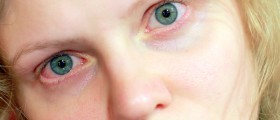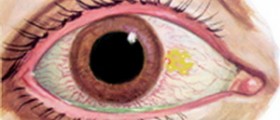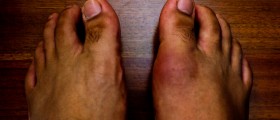
Pink eye, medically known as conjunctivitis, if inflammation of the conjunctiva. This membrane is covering the whites of the eyes and the inner surface of both eyelids. The inflammation is a consequence of various infections, viral, bacterial or fungal and may also occur in cases of allergies or exposure to the eye to certain irritants and pollutants.
Pink eye affects people of all ages. It is generally not serious and depending on the underlying cause is treated differently and has different prognosis.
Pink Eye - Infections Caused by Viruses
In the majority of cases pink eye develops as a consequence of viral infection. Adenovirus is the leading infectious agent responsible for this type of conjunctivitis. Viral conjunctivitis is frequently reported in late fall and early spring.
The affected eye is red, itchy and watery. There is no discharge and this is actually a sign that the infection is viral and not bacterial. Severe inflammation is accompanied by eyelids swelling. Photophobia or increased sensitivity to light my also occur. Before the conjunctiva gets inflamed, a patient may experience 'cold like' symptoms such as sinus congestion and runny nose.
Viral conjunctivitis lasts 1-2 weeks and the symptoms of the infection are most severe during the first few days. This is highly contagious infection. Viral conjunctivitis caused by Adenovirus is treated symptomatically.
Pink Eye - Infections Caused by Bacteria
There are many bacteria capable of causing bacterial conjunctivitis. Staphylococci and Streptococci are only some bacterial strains reported to cause pink eye in humans.
This infection develops rapidly and soon after being contaminated, the affected eye gets inflamed. There is eye pain, swelling of both eyelids, itchy sensation and redness of the entire conjunctiva. Depending on the bacteria, there is also various amount of discharge of different color (yellow, green etc.). If present in large amounts, discharge may cause sticking of the eyelids during the night which simply cannot be opened in the morning. Under these circumstances one should apply a warm washcloth to the eyes and gently remove the discharge.
Bacterial conjunctivitis is treated with antibacterial ointments and tear drops or the combination of the two. Once prescribed with eye drops or eye ointment, patients are not supposed to share these because this may lead to further spread of the infection. Bacterial conjunctivitis can be additionally spread after sharing towels contaminates with the eye discharge.
To sum up, any inflammation of the conjunctive must be reported. A well experience ophthalmologist will confirmed or rule out viral or bacterial conjunctivitis and prescribe appropriate treatment. Do not try to treat the condition on your own, because this may cause serious complications.
















Your thoughts on this
Loading...